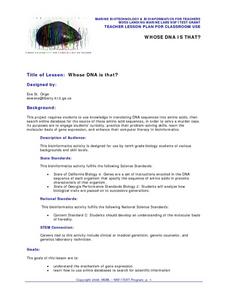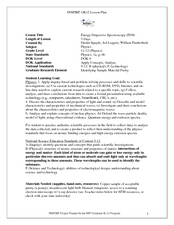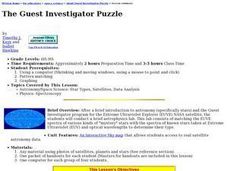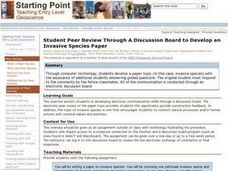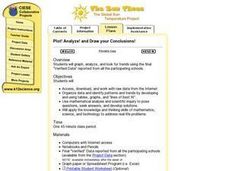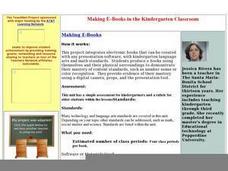Curated OER
Mars
First graders listen as the teacher reads a copy of the WEEKLY READER that talks about Mars and ask questions accordingly. They again listen as a section about Earth is read from the magazine. Now, the class orally compare and contrast...
Curated OER
Where Should We Place Archaeopteryx?
Pupils classify Archaeopteryx using pictures of actual fossils and scientist representations of how the animal might have looked. They compare Archaeopteryx's characteristics to those of the five extant vertebrate groups to...
Curated OER
Where to Live?
Students examine types of spatial data found in a GIS. In this geography lesson students use a GIS to facilitate analysis and decision making.
Curated OER
Visit My Class Wikis
Students visit the links on the blog site to learn about class wikis. In this technology integration instructional activity, students visit the links to view class wikis.
Curated OER
Satellite Tracker
Middle schoolers use satellite tracking software to monitor different satellites. They predict and graph the motion of the space station. They create a 3-D display of its path and share it with the class.
Curated OER
Whose DNA Is That?
Learners investigate the use of technology in order to identify different sequences of amino acids by using online web tools. They enhance problem solving skills with amino acid identification skills and strengthening comfort with using...
Curated OER
Energy Dispersive Spectroscopy
Students calculate the values of electron binding energies. In this physics lesson, students solve for different wavelength characteristics of X-rays. They present their findings to the class.
Curated OER
Ecology: Symbiosis
Eighth graders identify various types of symbiotic relationships. For this ecology lesson, 8th graders predict whether certain organisms can form symbiosis with other organisms. They discuss and defend their reasoning.
Curated OER
The Guest Investigator Puzzle
Students conduct a brief astrophysics lab matching the EUVE spectra of various kinds of "mystery" stars with the spectra of known stars taken at Extreme Ultraviolet and optical wavelengths to determine their type.
Curated OER
A Hair Raising Experience
Students rotate through various lab stations in groups as they experiment with the concepts of conduction, induction and friction. They use a generator, aluminum pie pans, paper, plastic, styrofoam and other materials to complete their...
Curated OER
Show Some Backbone and Teach Invertebrates
Fifth graders identify two similarities and two differences between two phyla, assign fictitious invertebrate to its phylum and explain why it belongs in that grouping, and construct member of given phylum and explain why it should be...
Curated OER
Animal Adaptations to Various Environments
Fourth graders examine animal adaptatations for various animals and different environments throughout the year. They use the Internet to research these environments and apply them to the animals.
Curated OER
Earthworms
Fifth graders research the earthworm and write a one paragraph report on its anatomy and habitat. They learn about worms and how to dissect them through Video Streaming and virtual dissections, along with actually dissect a worm as...
Curated OER
GIS Mapping: Special Instructions for Using Digital Orthophotos
Students practice cartography using GIS technology. They create a map of Austin using GIS and aerial photos.
Curated OER
Hurricanes-Disasters In the Making
Sixth graders discover the proper methods for plotting hurricanes while developing their understanding of hurricanes by researching and gathering tracking data from technological sources. Students develop a newsletter about hurricanes,...
Curated OER
Student Peer Review Through a Discussion Board to Develop an Invasive Species Paper
Students develop electronic communication skills through a discussion board while peer reviewing a paper on invasive species. Students work in groups of three to provide constructive feedback on a classmate's paper.
Curated OER
Cell Community
Seventh graders use technology to review cell structure and function. In this cells less, 7th graders review the parts and functions of a cell, and use photography/video and PowerPoint to enhance their explorations.
Curated OER
Plot! Analyze! Draw your Conclusions!
Students download data reported from the Global Sun Temperature Project website. They graph and analyze the data looking for trends and patterns. They prepare a class report with their observations and post it to the website.
Curated OER
What Is CLIVAR and EPIC?
Students conduct Internet research to analyze climatic conditions. They answer questions by conducting Internet research about CLIVAR and EPIC and write an essay about why climate research is an international issue.
Curated OER
Charting The Progress of New Horizons
Learners explore the long distances and timescales involved in space travel. They track the progress of the New Horizons spacecraft and access the New Horizons website to discover the distance of the spacecraft from the Sun, and then...
Curated OER
Looking To The Future
Young scholars examine life now and predict the future. They examine the long timescales involved in space travel
Curated OER
Making E-Books in the Kindergarten Classroom
Students produce e-books using themselves and their physical surroundings to demonstrate content standards, such as number sense or color recognition. They provide evidence using a digital camera, props, and the presentation tool.
Curated OER
Ethical Applications of Human Genetics
Tenth graders read about, observe case study videos, and participate in live interactive broadcasts, and maintain a log book on all of the activities pertaining to the Human Genome Project.
Curated OER
Using SWMP Data
Pupils are introduced to the SWMP system which tracks short-and long-term changes in water. Using this data, they plot and interpret the data on a graph to determine how human activities are lowering the water quality. They also identify...





